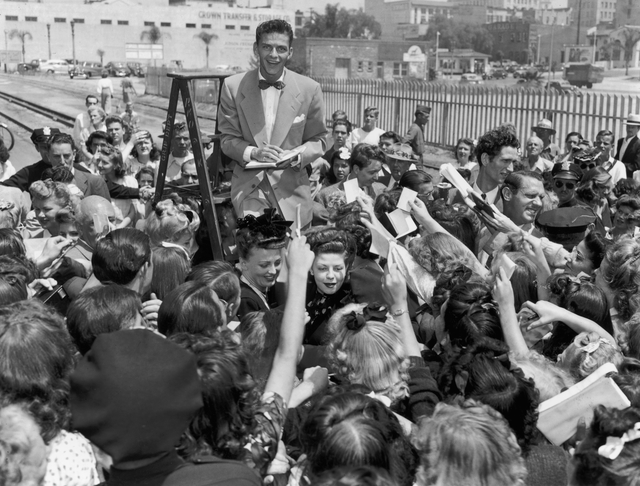
By Matt Micucci
The popularity of the male crooners in the forties, spearheaded by Frank Sinatra, led to the rise of the “bobby-soxers” and the birth of “swooning”
Frank Sinatra started his professional singing career as a teenager and by the forties he had risen to prominence, particularly by playing with the Dorsey Brothers Orchestra. He then went on to pursue a solo career which launched him into mega stardom of immense proportions in 1943.
Back in those days, the music of choise of the youth culture of America was the one of the big bands led by such greats as Benny Goodman and Glen Miller. But it was also the era of the male crooners, who often made the easy transition from record players to the big screen and included such big names as Van Johnson and Bing Crosby. The latter was Sinatra’s hero, but out of them all, it was Frankie himself who would become the undisputed king.
His popularity was so great that it inspired a whole youth cultural movement as well as star crazed reactions, the likes of which had never been seen before. All this much to the worry of the older generations.
It led rise, for instance to the practice of swooning, which is something that has been associated with Beatlemania but originated from the riot-inducing Paramount Theatre performances of Sinatra in the first part of the forties, back when he was playing to 10,000 people at the Hollywood Bowl. Swooning was something that seemed to blend the fine line between human and animal behaviours. Young women would growl and scream, flailing their arms in the air before placing a hand on the cheek, arm or hand of their heroes and ultimately fallen to the ground, overwhelmed in an extreme public display of infatuation.
It was Sinatra who also gave rise to the bobby-soxers. This was a sociological coinage for the youth culture in the forties that included very zealous fans of traditional pop music, and was usually composed by young and adult women bewteen the ages of 12 and 25. The name of the group originated from their attire. The girls would wear poodle skirts and roll their socks to their ankles. When dancing at the gymnasium of their school, they were required to take off their shoes, which led to them having to dance with their bobby sock, a practice which also originated the phrase “sock hop”.
In 1944, the Official Bobby Soxers of America organization – for there indeed was such a thing – named the old crooner their “Man of the Year”.
Sinatra influenced the fashion of the times also with some of the pieces of his own attire. He would wear polka dotted bowties, and they also became a popular item of clothing among the male and female sexes.
As ol’ blue eyes grew older, it wasn’t so much that his popularity grew less, but his first wave of fans grew older and, in the process, toned down. But it was arguably the bobby-soxers that established the foundations for what was to be one of the greatest long-lasting career of any entertainer in history. It is ironic to point out, however, that Sinatra would later on in life become critical of the growing popularity of the rock and roll movement later on in his career, and pointing his finger at many of the things that he himself had generated only a little over a decade earlier.
